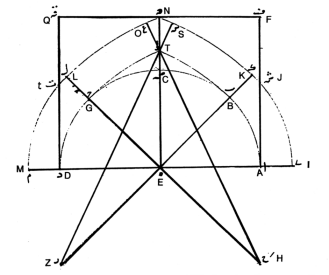
| Calculation of Arches and Domes in 15th Century Samarkand |
|---|
Dept. of Mathematics, University of Heidelberg
69120 Heidelberg, Germany
Ghiyath al-Din Jamshid Mas'ud al-Kashi ranks among the greatest mathematicians and astronomers in the Islamic world. He was a master computer of extraordinary ability, his wide application of iterative algorithms, and his sure touch in so laying out a computation that he controlled the maximum error and maintained a running check at all stages, in short, his talent to optimize a problem let him appear as the first modern mathematician. Outside the Samarkand observatory al-Kashi died in June 1429, probably murdered on the command of Ulugh Beg. Two years earlier he had finished the Key of Arithmetic, one of his major works. The work is intended for everyday use, as al-Kashi remarks: "I redacted this book and collected in it all, what is needed for him, who calculates carefully, avoiding tedious length and annoying brevity." By far the most extensive book is Book IV, On Measurements. Its last chapter, "Measuring Structures and Buildings", is really written for practical purposes:
"The specialists merely spoke about this measuring for the arch and the vault and besides that it was not thought necessary. But I present it among the necessities together with the rest, because it is more often required in measuring buildings than in the rest."
Al-Kashi uses geometry as a tool for his calculations, not for constructions. Besides arches, vaults, and domes (qubba) al-Kashi calculates here the surface area of a stalactite vault (muqarnas), to say, he establishes approximate values for such a surface. He is able to do so, because, although a muqarnas is a complex architectural structure, it is based on relatively simple geometrical elements. For the calculation only elementary geometrical rules are used.

In medieval Italy it was common practice to pay artisans according to the surface area they had completed. Also in seventeenth-century Safavid Iran architects were paid a percentage on each building based on the cubit measure of the height and thickness of the walls:
The Persians determine the price for masons on the basis of the height and thickness of walls, which they measure by the cubit, like cloth. The King imposes no tax on the sale of buildings, but the Master Architect, that is Chief of Masons, takes two percent of inheritance allotments and sales. This officer also has a right to five percent on all edifices commissioned by the King. These are appraised when they are completed and the Master Architect, who has directed the construction, receives as his right and salary as much as five percent of the construction cost of each edifice.
The same custom seems to have existed in the Arab world. It is also useful to know, more or less, how much material is needed like gold for gilding, bricks for construction or paint and such things. Payment per cubit was common in Ottoman architectural practice where a team of architects and surveyors had to make cost estimates of projected buildings and supply preliminary drawings for various options. In addition to facilitating estimates of wages and building materials before construction, al-Kashi's formulas may also have been used in appraising the price of a building after its completion. His sophisticated formulas were, like the simple formulas found in the Arithmetic Books, useful for everyday life. This was al-Kashi's objective for writing his Key of Arithmetic.
ILLUSTRATION: Construction of the second type of arch, three-centered, from al-Kashi's Key to Arithmetic.
ABOUT
THE AUTHOR
Yvonne
Dold Samplonius studied
mathematics and Arabic at the University of Amsterdam, specializing
in the History of Islamic mathematics. She wrote her thesis with
Prof Bruins, Amsterdam and Prof. Juan Vernet, Barcelona. The
academic year 66/67 she spent at Harvard studying under Prof.
Murdoch. She has published about forty papers on the History
of Mathematics. In the last years her interest has shifted to
Mathematics in Islamic Architecture from a historic point of
view. Under her supervision a video concerning this subject,
in particular arches and vaults, has been produced at the IWR
(Institute for Scientific Computing), Heidelberg. She is an associated
member of this institute. A second video, on reconstructing muqarnas
(Stalactite vaults) is in progress.
RELATED
SITES ON THE WWW
Muqarnas
website.
|
Yvonne Dold Samplonius, "Calculation of Arches and Domes in 15th Century Samarkand", pp. 45-55 in Nexus III: Architecture and Mathematics, ed. Kim Williams, Pisa: Pacini Editore, 2000. http://www.nexusjournal.com/conferences/N2000-DoldSamplonius.html |
|
|
|
|
